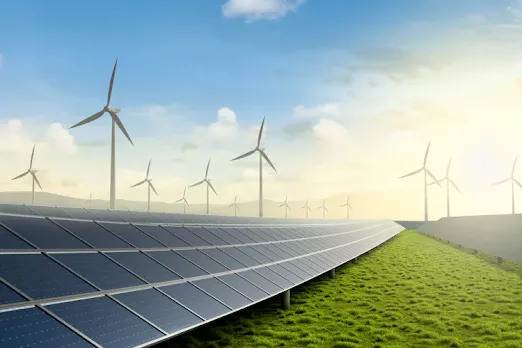New
Delhi, June 2025 –
India’s renewable energy sector is undergoing a transformative surge, driven by
record-breaking capacity additions, cutting-edge projects, and forward-thinking
regulation.
Record
Capacity Growth in FY 2024–25
- 25 GW of new clean energy
capacity was
added in FY 2024–25, marking a 35 % increase year-on-year – the
biggest surge yet under minister Pralhad Joshi.
- This brought total
non-fossil generation capacity to nearly 223 GW, approaching 47 %
of India’s total power generation capacity .
- Solar installations have
surpassed the 100 GW landmark, representing around 48 % of total
renewable capacity, while wind capacity hit 50 GW .
Flagship
Projects & Manufacturing Drive
- The Gujarat Hybrid
Renewable Energy Park in Kutch aims to deliver a massive 30 GW
hybrid solar-wind output, making it the world’s largest of its
kind.
- In Madhya Pradesh, the 600 MW
Omkareshwar floating solar plant remains among the largest globally,
continuing development post-commissioning in 2023.
- Gujarat’s Waaree Energies
launched a 5.4 GW solar-cell gigafactory in Chikhli, significantly
ramping up domestic manufacturing capacity
- Reliance’s Dhirubhai
Ambani Green Energy Giga Complex in Jamnagar continues to expand PV
modules, batteries, hydrogen, and electrolyser factories, aiming for 50–100 GWh
annual capacity by 2030.
Infrastructure
& Industrial Adoption
- The Central Electricity
Regulatory Commission (CERC) has proposed enabling Virtual Power
Purchase Agreements (VPPAs), allowing companies to financially support
clean energy without physical offtake.
- The Uttar Pradesh State
Industrial Development Authority is installing 13 solar plants
across major industrial zones—including a model plant in Kanpur—and
introducing “solar paths” and green belts.
- Telangana has set an ambitious target
of 20 GW renewable capacity by 2030, with MoUs worth ₹1 lakh crore
and pumped-hydro storage systems at its Greenko project.
Rooftop
& Decentralized Solar
- Over 11 lakh households
have benefitted from rooftop solar under the PM Surya Ghar Muft Bijli
Yojana, adding more than 3.3 GW of distributed solar.
- Schools in Prayagraj
are being equipped with rooftop solar under the PM Surya Ghar initiative,
expected to slash electricity bills by up to 70 %
- Nagpur leads Maharashtra in
rooftop uptake, with over 33,600 installations totalling 132 MW,
supported by generous subsidies.
Grid &
Storage Innovations
- Hitachi Energy is deploying High Voltage
Direct Current (HVDC) transmission systems and emphasizing energy-storage
integration for better management of intermittent sources.
- Pumped hydro storage is gaining traction in
Telangana and Odisha: Telangana’s Pinnapuram project operates two
four-hour cycles daily, while Welspun’s Odisha deal includes a
1,200 MW pumped-hydro and 1,000 MW floating solar MoU.
Environmental & Policy Impact
- Renewables now contribute ~23–24 %
to India’s electricity generation, with solar surging 32 %
year-on-year from January–April 2025.
- Coal's share fell below 50%,
and fossil-fuel generation declined slightly for the first time since
2020—a trend expected to continue through the monsoon season .
- The government plans to add 75 GW
of renewable capacity by FY 2027, backed by ₹3.8 lakh crore in
investments, though transmission constraints remain a challenge.
Looking
Ahead
With
scaling manufacturing, landmark mega-projects, digital PPA mechanisms, and
ambitious state-level targets, India’s renewable energy landscape is
accelerating toward a low-carbon, self-reliant future. Integration of advanced
grid and storage systems will be pivotal to ensure this clean energy boom is
both resilient and sustainable.






_2024-6-13-9-40-21_thumbnail.jpg)

0 Comments